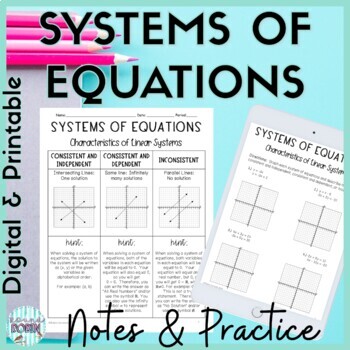Solving Systems of Equations Guided Notes
- Zip
- Google Apps™
- Microsoft OneDrive

Description
Give your Algebra I or Algebra II students an in-depth review of Solving Systems of Equations with these guided notes, practice, and optional quiz resources. Students will review solving systems of equations using any method including solving systems of equations by graphing, solving systems of equations by substitution, and solving systems of equations by elimination.
This resource is perfect for Distance Learning (zero prep) or in the classroom. It can be used with Google™ or Microsoft™. You will receive a pdf with the printables, a link to the google slides, a PowerPoint version, and an answer key.
You must have a free Google™ account to access the Google™ slides.
⭐ These worksheets can be used digitally or in-person with the provided pdf handouts included.⭐
11 pages plus answer keys of notes and practice problems include:
- 7 pages of guided notes include describing the systems as inconsistent, consistent/independent, or consistent/dependent. They also include solving the systems by graphing, substitution, and elimination using addition and multiplication.
- 2 quick reference sheets include additional practice problems using all 3 methods and combine the steps to solve and when the best time to use the appropriate method from the guided notes.
- 1 page of practice problems that can be used for homework contains a combination of 5 consistent/independent problems and 5 consistent/dependent and inconsistent problems.
- 1 page that can be used for additional practice or as a quiz
I used this as an in-class assignment with my students and they were questioning whether there were so many without solutions because they kept 2nd guessing themselves!
You may also like:
- Solving Systems of Equations by Graphing
- Completing the Square
- Solving Absolute Value Inequalities Digital Activity
Don't forget to leave a review to earn credit towards future resources at no extra cost to you!
Let's be social!





